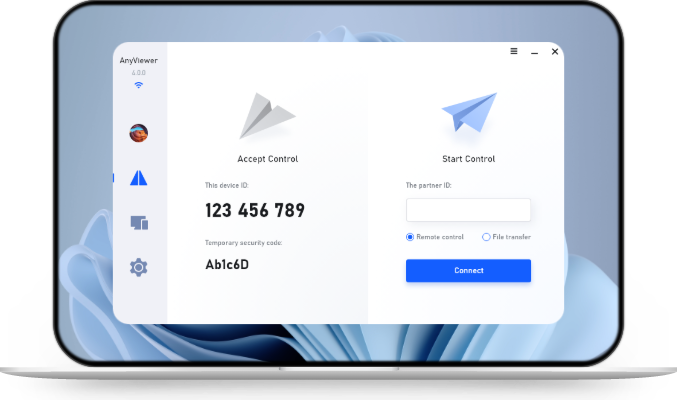Remote Server Management Services: A Game-Changer for IT Operations
Remote server management is key to keeping IT systems running smoothly. AnyViewer offers a simple, secure way to manage servers, monitor performance, and reduce costs. It helps businesses quickly respond to issues, ensuring systems stay up and running.
What are remote server management services?
Remote server management is essential to keeping your IT systems running smoothly and efficiently. It involves overseeing the performance, stability, and resource usage of servers located off-site, often spread across different networks. This method ensures your infrastructure remains responsive and experiences minimal downtime.
With remote server management, you gain around-the-clock access to monitor and manage your servers from virtually anywhere, using any internet-enabled device. It allows you to perform tasks such as remote login, executing administrative commands, tracking server health, receiving alerts for critical issues, and deploying updates or system changes—all without being physically present.
Through continuous monitoring and detailed reporting, you can gain real-time insights into server uptime, performance trends, and usage metrics. This gives IT teams the flexibility to troubleshoot, optimize, and maintain systems effectively, no matter where the servers are located.
Why is remote server management essential?
Managing servers remotely empowers IT teams to maintain and control systems without being physically present at the server's location. This capability is especially valuable for organizations with widespread infrastructure, such as regional offices, data centers, or international operations, eliminating the need for on-site administrators at every location.
If daily incidents and interruptions are bogging down your operations, it's a strong indicator that remote server management is overdue. Implementing such a system reduces operational disruptions, mitigates risks like data breaches, and boosts response times. Faster intervention means problems are often resolved before they escalate—saving both money and the company's reputation.
Remote management also plays a crucial role in handling system failures, regardless of the cause, whether internal mistakes, customer mishaps, third-party issues, or environmental events. Enabling proactive troubleshooting and rapid recovery, it helps protect the user experience and reduces the fallout for clients and stakeholders alike.
Types of server management: In-house vs. outsourced
When it comes to managing servers, organizations typically choose between two main approaches: handling the task internally or outsourcing it to external providers.
In-house server management
This approach relies on an internal IT team to oversee and maintain the organization's servers. With this setup, businesses invest in server management software that enables real-time monitoring, remote access, automation, and reporting. While this option often incurs higher costs, due to staffing and infrastructure, it offers direct control over your server environment. It's a practical solution for organizations with the technical expertise and resources already in place.
Remote management tools enhance in-house operations by allowing IT staff to monitor performance, respond to alerts, and perform updates from any location, which is especially valuable for distributed teams and large enterprises.
Outsourced server management
For businesses that prefer not to manage their servers internally, outsourcing is a flexible and cost-effective alternative. This model involves partnering with a managed service provider (MSP) who takes over the responsibility for monitoring, maintenance, updates, and support. It eliminates the need for dedicated internal staff and ensures that your infrastructure is managed by experienced professionals.
MSPs typically bring a wide range of specialized remote access tools and expertise, offering a higher level of service, scalability, and often faster response times—ideal for companies focused on reducing operational burden.
Choosing the right approach
The decision between internal and external server management depends on budget, available personnel, and business goals. Organizations with robust IT departments may benefit from the control and customization of in-house management. In contrast, those looking to streamline operations and cut costs may find value in outsourcing.
Regardless of the approach, having the right tools—especially remote monitoring and management solutions—is key to maintaining a reliable, secure, and high-performing server infrastructure.
Core features of remote server management software
Remote server management tools bring a powerful suite of capabilities to organizations aiming to lower operational costs and boost user satisfaction. By centralizing control, these solutions enable comprehensive monitoring, alerting, and administration across diverse technologies, spanning operating systems, applications, and both physical and virtual servers.
These platforms support remote access to systems, secure file transfers, terminal-based connectivity, command-line execution (via SSH), patch management, diagnostics, and backup processes. This wide range of features empowers IT teams to identify and address issues early—before they snowball into critical disruptions.
Here's a breakdown of key functionalities:
- Server Discovery and Inventory Mapping: Automated tools scan the network to detect servers, catalog their operating systems, services, ports, and software versions. This dynamic inventory is continuously updated, giving IT teams an accurate and evolving view of their infrastructure.
- Proactive Alerting: Receive instant notifications when systems show signs of trouble. Whether it's performance degradation or potential failures, alerting helps IT staff take swift action before users are impacted.
- Remote Command Execution (SSH Control): Execute administrative commands on distant servers from any device, streamlining maintenance, diagnostics, and configuration changes—without needing physical access.
- Secure File Transfers: Transfer files between your local machine and remote hosts safely. This feature is commonly bundled with SSH tools, ensuring encrypted file movements and efficient deployment of updates or patches.
- Downtime & Uptime Reporting: Track the availability of your remote systems over time. Reports can be segmented by day, week, or month, giving you the insight needed to identify trends and optimize performance.
- Root Cause Analysis Tools: Dive deep into execution logs and user activity history to uncover what actions triggered an issue. This is essential for troubleshooting, accountability, and refining operational processes.
With these capabilities, remote server management becomes an indispensable tool for DevOps engineers, system admins, IT operations teams, and decision-makers. It not only ensures systems run smoothly but also equips teams with the insight and agility needed to respond to modern IT challenges.
Remote server management with AnyViewer
AnyViewer stands out as a reliable, secure, and user-friendly remote support solution for remote server management. Designed to support both IT professionals and enterprise-level operations, AnyViewer enables seamless, real-time access to servers from virtually anywhere, eliminating geographical constraints and reducing the need for on-site interventions.
With AnyViewer, administrators can remotely connect to Windows-based infrastructure or macOS servers and perform critical management tasks like diagnostics, system updates, configuration changes, and performance monitoring. Its intuitive interface allows even complex server environments to be managed efficiently through a centralized dashboard.
Here are some key reasons why AnyViewer is an ideal choice for remote server management:
- Unattended Remote Access: Easily set up and manage unattended access to servers. This means IT teams can initiate sessions, troubleshoot issues, and execute tasks even if no one is physically present at the server location.
- Secure Connections: AnyViewer uses robust encryption protocols and multi-layered security measures, including two-factor authentication and session encryption, ensuring that sensitive data remains protected during every connection.
- Real-Time Monitoring: IT teams can view live performance metrics and monitor CPU/RAM usage for potential issues, helping teams respond proactively to performance anomalies or downtime.
- Screen Walls: Display multiple remote sessions on a single screen wall, allowing administrators to monitor several servers at once in real time for better situational awareness and faster incident response.
- Device Grouping: Organize devices into groups for easier management. This feature streamlines workflows by allowing bulk operations, status checks, and access controls based on group membership.
- Role Permission Management: Assign different roles and permission levels to team members to ensure secure and structured access. This supports efficient teamwork while protecting sensitive server operations.
- Multi-Session Management: With support for managing multiple sessions at once, AnyViewer makes it easier to oversee a fleet of servers simultaneously. IT staff can jump between servers without disconnecting and maintain oversight with minimal disruption.
- Cross-Network Capability: Whether the server is hosted in a remote data center, a branch office, or behind a NAT firewall, AnyViewer allows access across different networks without requiring complex port forwarding or VPN configurations.
- Effortless File Transfer: Seamlessly move log files, patches, configuration files, or backups between the remote server and local device using secure and fast file transfer protocols.
- Collaborative Access: Grant temporary or permanent access to team members or support engineers, allowing multiple users to collaborate on server maintenance or troubleshooting efforts in real time.
- Mobile and Desktop Compatibility: AnyViewer supports access from both desktop clients and mobile apps, ensuring IT teams remain agile and responsive, even while away from their desks.
Whether you're running a single critical server or managing an enterprise-scale infrastructure, AnyViewer simplifies remote server management while enhancing security, productivity, and operational efficiency. It’s especially valuable for MSPs, IT departments, and businesses with remote or hybrid work environments.
By integrating AnyViewer into your IT toolkit, you can confidently manage your servers with greater control, reduced downtime, and minimal overhead, ultimately driving better business continuity and performance.
Conclusion
Remote server management is essential for keeping IT systems secure, fast, and accessible. Whether handled in-house or by a service provider, having the right tools makes all the difference. Tools like AnyViewer offer secure, real-time access and easy management from anywhere. This helps reduce downtime, cut costs, and keep systems running smoothly.

